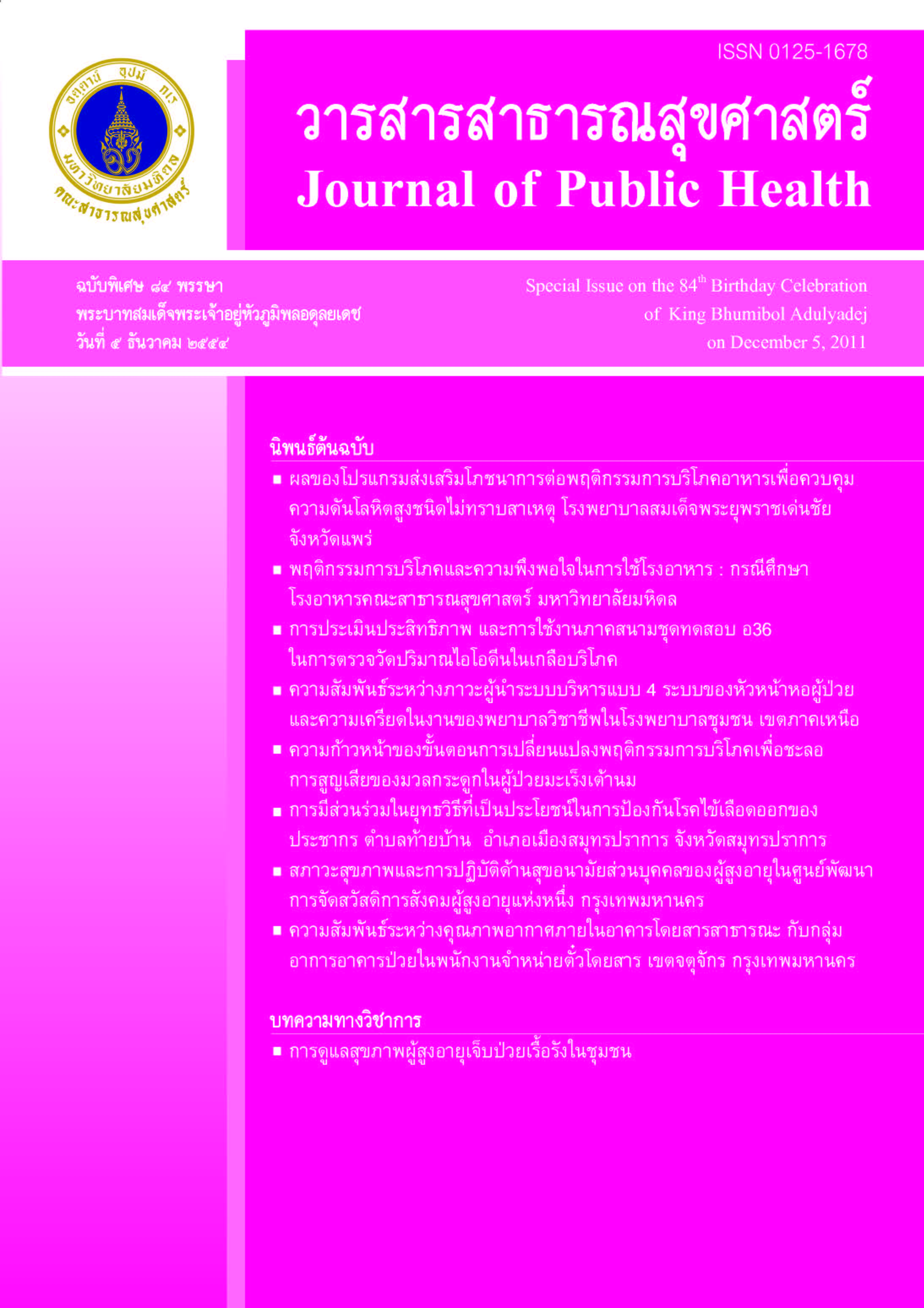การมีส่วนร่วมในยุทธวิธีที่เป็นประโยชน์ในการป้องกันโรคไข้เลือดออก ของประชากรตำบลท้ายบ้าน อำเภอเมืองสมุทรปราการ จังหวัดสมุทรปราการ
Keywords:
การมีส่วนร่วม, การป้องกัน, โรคไข้เลือดออก, Participation, Prevention, DengueAbstract
บทคัดย่อ
การวิจัยนี้เป็นการศึกษาแบบเชิงพรรณนา มีวัตถุประสงค์เพื่อศึกษาลักษณะการมีส่วนร่วมในการป้องกันโรคไข้เลือดออกของประชากรตำบลท้ายบ้าน อำเภอเมืองสมุทรปราการ จังหวัดสมุทรปราการ เก็บข้อมูลโดยใช้แบบสอบถามๆ หัวหน้าครัวเรือนที่มีอำนาจตัดสินใจในการมีส่วนเข้าร่วมกิจกรรมการป้องกันโรคไข้เลือดออกและอาศัยอยู่ในตำบลท้ายบ้าน รวม 400 คน ศึกษาระหว่างเดือนกรกฎาคม ถึง สิงหาคม 2553 ใช้สถิติเชิงพรรณนา
การมีส่วนร่วมของประชากรในการป้องกันโรคไข้เลือดออกมี 4 รูปแบบ ได้แก่ (1) การมีส่วนร่วมในการมีอำนาจตัดสินใจต่อการป้องกันโรคไข้เลือดออก โดยประมาณหนึ่งในสามของประชากรได้ปรึกษาพูดจากับครอบครัวในด้านการป้องกันโรค (ร้อยละ 51.0) (2) การมีส่วนร่วมโดยการปฏิบัติในกิจกรรมต่างๆ เพื่อลดการติดเชื้อ เกือบครึ่งหนึ่งของประชากรที่ศึกษาดำเนินการอย่างสม่ำเสมอในด้านต่างๆ โดยที่ดำเนินการมากที่สุดเป็นประจำ คือการทำความสะอาดบ้านเรือนและจัดบ้านไม่ให้มีมุมมืด (ร้อยละ 80.7) (3) การมีส่วนร่วมโดยได้รับผลประโยชน์จากกิจกรรมต่างๆ พบว่าประชากรเกินครึ่งหนึ่งได้รับผลประโยชน์ในด้านต่างๆ โดยสมาชิกในครอบครัวได้รับความรู้ในเรื่องโรคไข้เลือดออกอย่างสม่ำเสมอ (ร้อยละ 66.3) และ (4) การมีส่วนร่วมในการประเมินผลจากกิจกรรมการป้องกันโรคไข้เลือดออก พบว่าประมาณครึ่งหนึ่งมีการดำเนินในด้านต่างๆโดยได้รับความรู้เกี่ยวกับโรคไข้เลือดออกจากสื่อรูปแบบต่างๆ การอบรม และจากเจ้าหน้าที่สาธารณสุข (ร้อยละ 56.7)
ผลสรุปพบว่าการให้ความร่วมมือของประชากรในพื้นที่ศึกษาในภาพรวม อยู่ในเกณฑ์ปานกลางขึ้นไป(ร้อยละ 92.5)
คำสำคัญ : การมีส่วนร่วม; การป้องกัน; โรคไข้เลือดออก
ABSTRACT
This descriptive study was conducted to determine the participation in dengue prevention of people livingin the Sub-district of Tai-Ban, Muang Samut Prakan District, Samut Prakan Province. All study data was collectedutilizing a structured questionnaire. Respondents totally numbered 400 were the heads of the households in theSub-district of Tai-Ban and possessed the power to make decisions regarding dengue prevention and control. Studywas conducted between July and August of 2010. Simple statistics were used in this study.
Four areas of participation in dengue prevention were identified. The first area involved participatingin decisions concerning on dengue prevention activities. This was found that almost one third of the populationalways consult and discuss in the family concern on dengue prevention (51.0%). Second area involved participatingin physical practices on dengue prevention. Almost half of them engaged in many categories for the preventionof dengue and found highest in being regular house cleaning and arrange indoor not have the dark place corner(80.7%). Third area involved participating in benefits from having engaged activities on dengue prevention. It wasfound that half of the population received benefit in many categories. Their families always gain the knowledgeon dengue hemorrhagic fever which was the highest found (66.3%). Fourth area involved participating on dengueprevention by evaluation. It was found that half of them always doing in many categories. The evaluation highestwas evaluated from the knowledge on dengue hemorrhagic fever from multimedia sources, training and healthvolunteers (56.7%).
Results of this study indicated that 92.5% of those participating in dengue prevention engage at mediumup levels.
Key words: Participation; Prevention; Dengue
Downloads
Issue
Section
License
Creative Commons License CC-BY-ND


